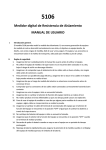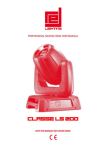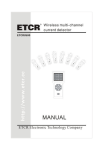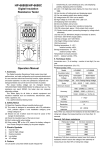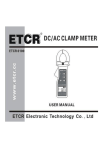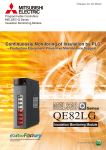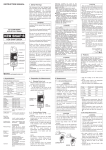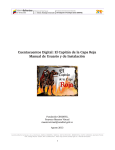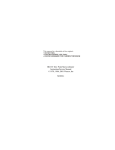Download I. General Introduction II. Safety Rules III
Transcript
I. General Introduction The brand new 510 Series instrument can measure insulation resistance, AC voltage and phase sequence. As a new generation all mighty electrical test instrument we have successfully developed recently , it has made fundamental changes to the circuit industry of conventional insulation resistance . Aided by the nice and fashionable design, 510 Series have more and stronger functions , are easier to use and more reliable . The instrument and accessories are all in the toolbox , fit for field application . It can be used to test the insulation resistance of power system , electrical equipment , lightning arrester equipment , and measure AC voltage and phase sequence test . II. Safety Rules 1. Be sure to read this user manual carefully before using this instrument. 2. Do not use this instrument when the rear cover is not in place, or you may get electrical shock. 3. Be sure to check the insulation layer of the probe is sound and free of any damage before using this instrument. 4. To prevent electrical shock, be sure not to touch electric lead and circuit when the test is in process. 5. Be sure to confirm the range selection switch has been set in the appropriate range before testing. 6. Confirm the plug of the wire has been tightly inserted in the terminal. 7. Be sure not to use the instrument when it is moist 8. Be sure not to turn the function selection switch when the test is in process. 9. Do not apply any voltage higher than 600V, AC or DC between test terminals. 2 VI. Operation Instruction 1. Safety Precautions Be careful of the high voltage shock. When the ① insulation resistance test is over, be sure to confirm the high voltage on the object under test has been discharged. Do not touch the object under test when the test is in ② process in case you should get electrical shock. The object under test shall not be live and be sure to ③ confirm the object under test is securely earthed when you test the insulation resistance . Short circuit the two test terminals of the object under test to discharge before you start the test . Do not include any external voltage into the test loop ④ when you test the insulation resistance. Be sure to confirm the knob switch is in right position ⑤ and the test wire is firmly connected before you start the test. When the high voltage switch has been turned on, ⑥ up to 5000V high voltage is generated between L terminal and E terminal . Be sure not to touch any exposed part of instrument and the object under test, otherwise you may get electrical hazard. 2. AC Voltage Test Do not test any voltage higher than 600V. ① Connection of Test Terminals. ② Insert the red test lead into the ACV socket of the instrument and the black test lead into the G socket of the instrument. Set the rotary switch at the “600V”position and ③ connect the probe to the object under test. The value displayed by the instrument now is the AC ④ voltage between two terminals of the object under test . 6 3. Test of Insulation Resistance. Connection of Test Terminals ① Insert the red test lead into the L socket of the instrument and the plug of the black test lead with flat crocodile clamp into the E socket of the instrument . Test connection ② The wiring of E socket of the instrument is the earth wire ; The wiring of L socket of the instrument is the line wire. The G terminal socket of the instrument is the shield wire to test the high insulation resistance. If necessary, insert the plug of the black test wire with probe into the G terminal socket of the instrument, to eliminate the measurement error caused by the leak current in the surface of the product, and ensure the accuracy of the test ; ③ Selection of Rated Voltage Select the rated voltage you need to test the insulation resistance by turning the knob to the relevant voltage class. ④ Test Operation Connect the other terminal of the wire to the object under test . Press the Test / Stop key , the red indicator turns on , indicating the high voltage output of test is connected. When the test has started, the LCD of the instrument displays some readings. The value displayed by LCD is the insulation resistance of the object under test. When the high voltage indicator is on, it indicates the test instrument is working properly. Turn off ⑤ When the test is over , press the Test / Stop key , the red indicator turns off , indicating the test high voltage has been disconnected . Put the DIP switch at OFF position, LCD displays nothing. For capacitive load, be sure to discharge the residual charges in the 7 10. Do not test in inflammable environment since spark may lead to explosion. 11. Stop using the instrument in case any metal is exposed because the shell or test wire is broken when the test is in process. 12. Be sure that the test wire has been removed from the test terminal and the function range selection switch is in the OFF position when you remove the rear cover to replace battery. 13. Do not replace battery when the instrument is moist. 14. Be sure to put the function range selection switch at the OFF position when your work is over. 15. Remember to remove the battery when you are going to not use the instrument for a long period of time. 16. When the instrument displays “ ” , replace battery promptly , to ensure the accuracy of measurement . III. Performance Features 1. Low power consuming CMOS dual integral A/D conversion IC, automatic zero 2. LCD: 3 1/2 bit large screen display, maximum reading 1999 3. Data holding function, functional icons display 4. Can measure voltage lower than AC600V 5. Low Battery indication 6. LCD backlight function 7. Can test phase sequence 8. Automatically convert range ( Insulation test only ) 9. Perfect protection circuits, which can effectively prevent the harm of reverse voltage 10. LCD dimension: (65x48)mm (digit is 29 mm high ) 11. Power: 8x1.5V (R6 AA) battery 3 object under test before you remove the test wire , to prevent the residual charges discharge and harm people . 4. Phase Sequence Measurement Method(5101A, 5102A,5103A) There is high voltage in the 3 - phase wire . It would be highly dangerous to touch, therefore be sure to handle with care when you connect wires for a 3-phase measurement. In case the instrument indicator is not on when the test wire has been connected, one phase may be live. Be careful not to get shocked. Do not test any voltage that is higher than the rated voltage of 100V450V / 40-60Hz ( 3- phase AC ) . Do not measure for more than 30 minutes when the voltage is higher than 200V and not more than 3 minutes when the voltage is higher than 450V. The duration mentioned above commences from the moment the probe wires of two phase sequences are connected. The phase sequence function allows you to test the ① phase sequence of 3-phase AC power supply (100V450V/40-60Hz). When you have connected the phase sequence probes with the test wires by input terminals , you can judge the positive phase and reverse phase of 3 - phase AC according to LED indicator and beep, and phase missing indicated by LED . Test State ② Phase Sequence Test Indication Open Phase Test Indication Beep Positive phase (CW indicator is on) L1, L2 and L3 indicators are on. Long beep Reverse phase (CCW indicator is on) L1, L2 and L3 indicators are on. No beep Missing phase (CCW indicator is on) No beep Any of L1, L2 and L3 is not on Note: When the measurement probes have been connected, the phase sequence measurement function shall indicate the positive phases and reverse phases of a 3-phase AC, and the LED indicator will indicate the phase missing. Be sure to measure with 3 triple-color test wires with 3 round crocodile clamps . Contents General Introduction … … … … … … … … …………2 Safety Rules … … … … … … … … … … … … …………2 Performance Features … … … … … … … … …………3 Specification … … … … … … … … … … … … …………4 Operation Schematic View … … … … … … …………5 Operation Instruction… … … … … … … … … …………6 Maintenance … … … … … … … … … … … … …………9 Accessories … … … … … … … … … … … … …………9 Warning This user manual includes warning and safety specifications, which shall be strictly followed to ensure safety. Please be sure to read through this user manual before using this instrument. 8 1 12. Dimension: 190x155x75mm 13. Weight: approximately 900g(including batteries) 14. The instrument and accessories can be put into one for easy carriage 15. Environment conditions 16. Operating temperature: 0C~40C Relative humidity<80% Storage temperature: -10C ~50C Relative humidity<80% 3. Phase Sequence Test(only 5101A,5102A,5103A) Phase-phase voltage range tested: 100V-450V Frequency tested: 40-60Hz 4. Phase Sequence test result is indicated by LED No and display in LCD V. Operation Schematic View 1 2 3 INSULATION HV IV. Specification Accuracy: ( %reading+digit ) the warranty is one year Environment temperature: 23℃±5℃ Relative humidity: <75% 1. Insulation Resistance Model Testing Volatge Out Voltage Range 5103A 5101A 5102A 250 / 500 / 1000V 500 / 10 0 0 10 00 / 250 0 250 / 500 100 / 250 / 10 0 0 / 2500V / 5 0 0 / 1000V / 2500V / 5000V 5104A 90%-110% of the test voltage 0.1MΩ-20GΩ 0.1MΩ-200GΩ 0.1MΩ-20GΩ 0.01MΩ Resolution 0.1MΩ-200MΩ±(3%rdg+5dgt) Accuracy 5105A 200MΩ—10GΩ±(5%rdg+5dgt) 10GΩ—200GΩ±(10%rdg+5dgt) 2. AC Voltage Measurement Measurement range: 0-600V Accuracy: ( 2% rdg+5dgt ) Resolution:1V Test frequency: 50/60Hz 4 L1 L2 L3 D.H PHASE CW CCW 13 12 11 L1 L2 E L 10 9 L3 / G MAX Test 4 5 6 7 700V ACV 8 1. LCD display 2. Phase sequence measurement LED indicators (CW, CCW, L1, L2 and L3) 3. Insulation resistance measurement high voltage LED indicator 4. Data holding switch 5. Test button 6. Backlight indicator switch 7. Function switch 8. ACV Input terminal 9. LINE input terminal ( Insulation ) 10. EARTH input terminal ( Insulation ) 11. Phase sequence L 1 input terminal 12. Phase sequence L2 input terminal 13. Phase sequence L3/ACV measurement G terminal / shield input terminal for insulation 5 510 Series Digital Insulation Resistance Tester OPERATION MANUAL Model: 5101A 5104A 5102A 5105A 5103A Rev 4 . 0 510 Series Digital Insulation Resistance Tester OPERATION MANUAL Model: 5101A 5104A Rev 4 . 0 5102A 5105A 5103A VII. Maintenance This instrument is a precision electronic instrument, be sure to maintain it well. 1. Do not apply the instrument to any AC voltage higher than 600V. 2. Do not use the instrument when the rear cover of the instrument is in place. 3. To replace battery, remove the probe and power off the instrument first. Unscrew the screws of the battery cover and remove the battery cover. Be sure to replace the battery according to the specification requirement. 4. Do not forget to remove the battery if you are not going to use the instrument for a long period of time . Place the instrument at a dry and well ventilated environment. 5. Do not alter any internal circuit of this instrument at will in case it is damaged. VIII. Accessories 1. One copy of user manual 2. 1 toolbox 3. 2 sets of dedicated test wires (a phase sequence test wire, an insulation resistance test wire 4. 8 cells of 1.5V AA batteries 9 VII. Maintenance This instrument is a precision electronic instrument, be sure to maintain it well. 1. Do not apply the instrument to any AC voltage higher than 600V. 2. Do not use the instrument when the rear cover of the instrument is in place. 3. To replace battery, remove the probe and power off the instrument first. Unscrew the screws of the battery cover and remove the battery cover. Be sure to replace the battery according to the specification requirement. 4. Do not forget to remove the battery if you are not going to use the instrument for a long period of time . Place the instrument at a dry and well ventilated environment. 5. Do not alter any internal circuit of this instrument at will in case it is damaged. VIII. Accessories 1. One copy of user manual 2. 1 toolbox 3. 2 sets of dedicated test wires (a phase sequence test wire, an insulation resistance test wire 4. 8 cells of 1.5V AA batteries 9





